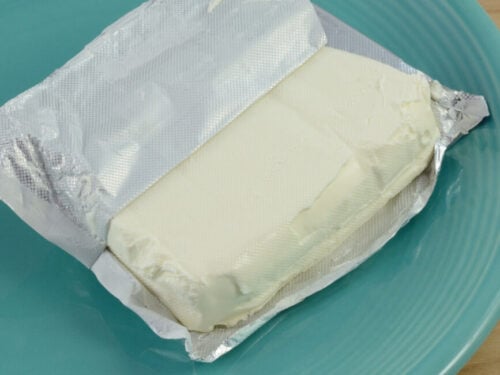Imagine this: you’re in your kitchen on a lazy Sunday morning, about to whip up a batch of your famous bagels or maybe even tackle that cheesecake recipe you’ve been eyeing. You reach for that essential ingredient – cream cheese – and suddenly, you’re hit with a culinary curveball. Should this creamy delight be kept in the fridge until the very last minute, or is it okay to let it hang out on the counter for a while?
It’s a common kitchen quandary that many of us face. Cream cheese, with its versatile and deliciously tangy profile, finds its way into our fridges, but then what? Some of us have faced that moment of doubt, especially when we come across a forgotten package in the back of the fridge or when we leave it out a bit too long during prep.
In this blog post, we’re diving into the creamy world of cream cheese to answer that all-important question: To refrigerate or not to refrigerate? We’ll sift through the facts, debunk some myths, and set the record straight on the best ways to store this beloved spread. Whether you’re a bagel buff, a cheesecake champion, or just a cream cheese enthusiast, you’re in the right place to get the scoop on keeping your cream cheese in tip-top shape.

What is Cream Cheese All About?
Before we dive into the chilly details of refrigeration, let’s take a moment to appreciate what cream cheese actually is and the delicious variety it comes in. Understanding this creamy delight’s essence will help us grasp why and how we should store it.
The Basics of Cream Cheese
- A Dairy Delight: At its heart, cream cheese is a soft, mild-tasting cheese made from milk and cream. It’s known for its smooth, spreadable texture and slightly tangy flavor.
- The Making of Cream Cheese: The process involves fermenting milk and cream with a lactic acid starter, which thickens the mixture. Then, it’s heated and stabilized, giving it that signature creamy texture we all love.
Exploring the Types of Cream Cheese
- Regular Cream Cheese: This is the classic, full-fat version, perfect for spreading on bagels or stirring into recipes for a rich, creamy texture.
- Whipped Cream Cheese: Air is whipped into this variety, making it lighter and fluffier. It’s a dream to spread and a favorite for those who prefer a lighter texture.
- Flavored Varieties: From garden vegetables to strawberries, flavored cream cheeses add a twist to the traditional taste. They’re great for adding a quick flavor boost to snacks and recipes.
- Reduced-Fat Options: For the health-conscious, there are reduced-fat and even non-fat versions. These are altered to lower the fat content while trying to maintain as much of the original taste and texture as possible.
Cream Cheese in the Culinary World
- Versatility is Key: Cream cheese’s real charm lies in its versatility. It’s a star in both savory and sweet dishes – from frostings and fillings in baked goods to creamy sauces and dips.
- Texture Talk: The texture of cream cheese plays a big role in recipes. It provides a smooth, creamy consistency that’s hard to replicate with other ingredients. This texture factor is also why how we store cream cheese is so important.
Knowing what cream cheese is made of and its various forms sets us up perfectly to understand why storage – specifically refrigeration – plays such a crucial role in maintaining its quality, safety, and delectable texture. Up next, let’s spread into the reasons why cream cheese should be kept cool in the fridge.

Reasons to Refrigerate Cream Cheese
Now that we’ve got a taste of what cream cheese brings to the table, let’s chill for a bit and talk about why keeping it in the fridge is crucial. From the perspective of food safety to maintaining its irresistible quality, there are several key reasons why your cream cheese belongs in the cold zone.
Food Safety First
- Bacteria Beware: Cream cheese is a high-moisture dairy product, which makes it a potential playground for bacteria if not stored correctly. Refrigeration dramatically slows down bacterial growth, especially harmful ones like Listeria and Salmonella.
- Playing It Safe: The risk of foodborne illness increases significantly when cream cheese is kept at room temperature for extended periods. That’s why keeping it refrigerated is essential for food safety.
Keeping Quality and Freshness
- Texture and Taste: Cream cheese’s appealing texture and taste can quickly deteriorate if not kept cool. Refrigeration helps maintain its smooth, creamy consistency and prevents it from becoming too soft or separating.
- Shelf Life Extension: In the fridge, cream cheese can stay fresh and tasty for several weeks. This shelf life drastically reduces once it’s left at room temperature for too long.
Opened vs. Unopened Packages
- Unopened Packages: An unopened package of cream cheese can last quite a while in the fridge, often until the sell-by date, thanks to its sealed environment.
- Once Opened: After opening, cream cheese should be used within about 10 days for optimal quality. Keep it wrapped or in a closed container to prevent it from absorbing odors from other foods in the fridge.
A Note on Freezing Cream Cheese
- Freezing is an Option: While freezing cream cheese can extend its shelf life, be aware that it may alter the texture, making it crumblier and less creamy. This change makes it better suited for cooked or baked dishes post-thawing, rather than as a spread.
In summary, refrigerating cream cheese is non-negotiable for ensuring both safety and quality. Whether your cream cheese is waiting to be transformed into a cheesecake or slathered on your morning bagel, keeping it cool in the fridge is the way to go.

The Risks of Improper Storage
While we all might be guilty of a little kitchen forgetfulness now and then, leaving cream cheese out of the fridge for too long is a no-go. Let’s spread the details of what happens when this dairy delight isn’t stored properly and how to spot when it’s past its prime.
The Spoilage Saga
- A Breeding Ground for Bacteria: Remember, cream cheese loves moisture, and unfortunately, so do bacteria. At room temperature, bacteria can multiply rapidly, leading to spoilage and potential foodborne illnesses.
- Risks Involved: Eating spoiled cream cheese can result in food poisoning symptoms like stomach pain, nausea, vomiting, and diarrhea. Not exactly what you signed up for when reaching for that bagel spread, right?
Spotting Spoiled Cream Cheese
- Visual Clues: Keep an eye out for any signs of mold. This could be green, black, or even pink spots on the surface. Mold in cream cheese isn’t just surface deep; it can permeate the entire product.
- Texture Tells: If the texture of the cream cheese has changed – if it’s become unusually runny or has separated – it’s a red flag.
- Sniff Test: Trust your nose. Fresh cream cheese has a mild, creamy smell. If it’s started to go bad, it will have a sour or even rotten smell.
- Taste Test: This should be your last resort, but spoiled cream cheese will have an off-taste. If you’re unsure based on the other cues, it’s best to err on the side of caution and toss it.
The Room Temperature Rule
- The Two-Hour Threshold: As a general guideline, cream cheese should not be left at room temperature for more than two hours. Beyond this, the risk of bacterial growth and foodborne illness increases significantly.
Proper storage of cream cheese is not just about maintaining its quality and flavor; it’s also about keeping it safe to eat. Understanding these risks and knowing how to identify spoiled cream cheese can save you from an unpleasant culinary experience.

Safe Practices for Using and Storing Cream Cheese
Now that we’ve covered the ‘why’ of refrigerating cream cheese, let’s spread into the ‘how.’ Keeping cream cheese delicious and safe is easy when you follow these handy tips for using and storing it. Let’s cream through them!
Tips for Safe Usage
- Avoid Double Dipping: Always use a clean knife or spreader when digging into your cream cheese. This prevents cross-contamination and keeps things hygienic.
- Spoon it Out: If you’re using cream cheese for a recipe, spoon out the amount you need instead of dipping the whole container into your other ingredients. This keeps the remaining cream cheese fresh and free from other food particles.
- Keep It Covered: After using, make sure to seal your cream cheese properly. Whether it’s in its original packaging or a container, keeping it covered prevents it from absorbing other flavors and odors in the fridge.
Storing Cream Cheese in the Fridge
- Original Packaging Works Best: For unopened cream cheese, the original packaging is designed to keep it fresh. Just pop it in the fridge until you’re ready to use it.
- After Opening: Once opened, if the cream cheese doesn’t come in a resealable container, transferring it to an airtight container or wrapping it tightly in cling film is a good idea to maintain freshness and prevent it from drying out.
Handling Cream Cheese During Usage
- Room Temperature for Short Periods: It’s okay to let cream cheese sit at room temperature for a short time while when you’re using it. This makes it more spreadable and easier to mix into recipes.
- Mind the Time: Remember the two-hour rule. Don’t leave cream cheese out for more than two hours at a time. If you’re done using it, back into the fridge it goes!
Special Consideration for Flavored or Specialty Cream Cheeses
- Check the Label: Flavored or specialty cream cheeses may have different storage instructions, so always check the label. Some might be more perishable than others, especially those with fresh ingredients like herbs.
By following these simple yet effective tips, you can ensure your cream cheese stays fresh, safe, and utterly scrumptious.

Other Cream Cheese Queries
We’ve covered a lot of creamy ground so far, but there’s always more to spread! Let’s tackle some other common curiosities about cream cheese, ensuring you’re fully prepped to handle this dairy delight with all the facts at your fingertips. So, let’s dive into these frequently asked cream cheese questions.
Can You Freeze Cream Cheese?
- Freezing Facts: Yes, you can freeze cream cheese, but there’s a catch. Freezing can change its texture, making it more crumbly and less creamy. This isn’t a big deal if you’re using it in cooked dishes, but it might not be ideal for spreads or dips.
- How to Freeze: If you decide to freeze it, wrap the cream cheese tightly in plastic wrap or aluminum foil and place it in a freezer bag. It can last in the freezer for several months.
What’s the Best Way to Thaw Frozen Cream Cheese?
- Thawing 101: The best way to thaw frozen cream cheese is in the refrigerator. This slow thawing method helps maintain as much of the original texture as possible.
- Quick Thawing: In a pinch, you can thaw cream cheese on the countertop for an hour or so, but remember the two-hour rule to avoid any food safety issues.
Homemade Cream Cheese: Is It Different?
- DIY Cream Cheese: Making cream cheese at home is a fun and rewarding endeavor. Homemade cream cheese often has a fresher taste but a shorter shelf life compared to commercial varieties.
- Storage Considerations: Store homemade cream cheese in the fridge, and consume it within a week or so for the best quality and safety.
How Long Does Cream Cheese Last After Opening?
- Post-Opening Lifespan: Once opened, cream cheese should be used within about 10 days for the best quality. Make sure it’s well covered or stored in an airtight container during this time.
Is Cream Cheese Healthy?
- Nutritional Notes: Cream cheese is rich in nutrients like vitamin A and calcium but is also high in fat, particularly saturated fat. Enjoying it in moderation is key, especially if you’re watching your calorie or fat intake.
- Balancing Your Diet: Incorporate cream cheese into a balanced diet by pairing it with whole grains, fruits, or veggies for a more nutritious snack or meal.
With these answers in your culinary toolkit, you’re now a bona fide cream cheese whiz!

Spreading to the End
Whether you’re a cream cheese newbie or a seasoned schmear expert, I hope this post has dolloped some new insights onto your cream cheese knowledge. Remember, when it comes to cream cheese, keeping it cool in the fridge is key, and enjoying it is an art worth perfecting!
Now it’s your turn to spread the joy! I’d love to hear from you in the comments. Do you have any cream cheese hacks, favorite recipes, or creative uses that make your culinary heart beat a little faster? Maybe a secret family recipe that turns cream cheese into the star of the show? Share your experiences, tips, and all things cream cheese. Let’s turn the comments section into a treasure trove of creamy creativity!
Here are Some of Our Favorite Recipes that Include Cream Cheese
- Peanut Butter Pie
- Strawberry Almond Cream Tart
- Chocolate and Coffee Cupcakes with Coconut Frosting
- Baked Crab Rangoons
The post Should Cream Cheese Be Refrigerated? appeared first on Steamy Kitchen Recipes Giveaways.
from Steamy Kitchen Recipes Giveaways https://ift.tt/nw6T0py
via New Kitchen Special
No comments:
Post a Comment